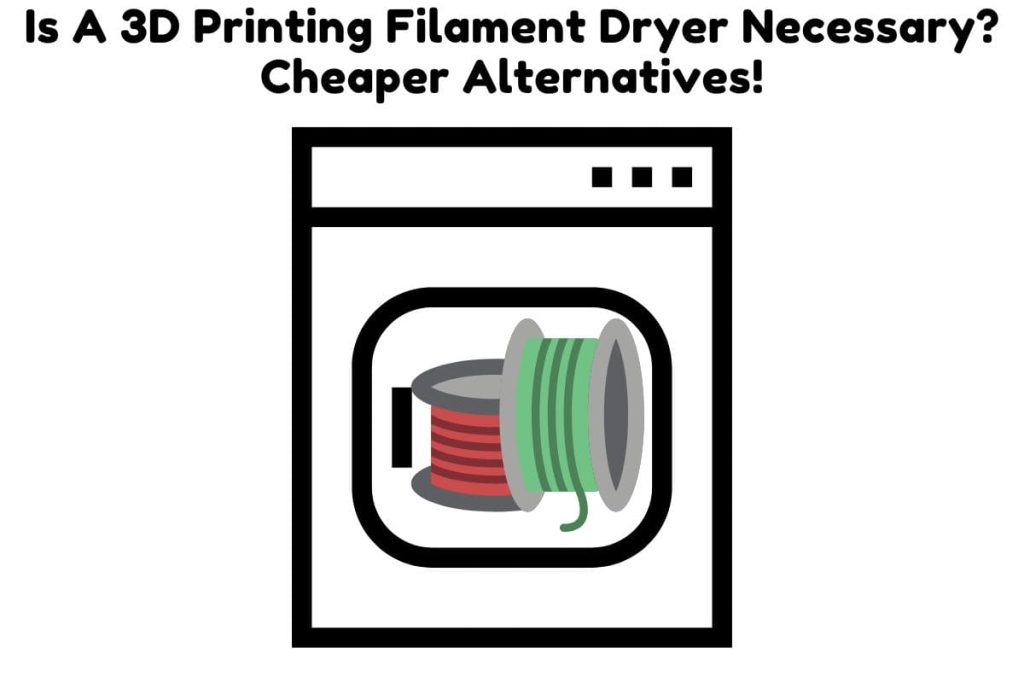Preparation and post-processing can mean the difference between a great print and a print destined for the scrap heap. Any 3D printing enthusiast can tell you how post-processing techniques like sanding can make even the most average design shine. But can preparation have the same effect, and if so what type of preparation?
Drying filament before you use it is widely recommended in 3D printing forums and literature. But should you always dry filament? What impact does it have on your prints and what would happen if you didn’t?
Working with wet filament produces poor quality prints. Wet filament will always produce a print with flaws like bubbles or cracks. In some cases, wet filament will clog up the nozzle and jam the printer. This is because the filament swells up when it absorbs moisture. Using a filament dryer is not necessary but it could help with avoiding the issues commonly arise from using wet filaments
In this guide, we examine how moisture affects filament and the several techniques you can use to dry your filament.
On a side note! If you’re looking for a reliable and high-quality 3D printer, we highly recommend the Official Creality Ender 3 V2 Upgraded 3D Printer (Amazon Link).
This printer is an upgraded version of the popular Ender 3 model, with a range of new features and improvements that make it even easier and more convenient to use.


- What Happens If You Don’t Dry Your Filament?
- How Do You Dry A 3D Printer Filament?
- Can You Use A Food Dehydrator To Dry Filament?
- Is It Safe To Dry Filament In The Oven?
- Does PLA Need A Filament Dryer?
- What Are The Pros And Cons Of Using A 3D Printing Filament Dryer?
- How Often Should I Dry Filament?
- How Long Can PLA Sit Out?
What Happens If You Don’t Dry Your Filament?
Wet filament is hard to detect just by looking at it. But you can tell when filament is wet if you try to extrude it and your printer starts to make popping sounds. There might also be bubbles or steam coming from the filament as you print.
The end result will always be a print with defects in it. For example, you might see poor adhesion between the layers of your print caused by the moisture in the filament.
How Do You Dry A 3D Printer Filament?
Drying filament removes the possibility of prints failing due to moisture saturation. There are several ways of drying filament with some involving specialized drying equipment and some improvised DIY solutions. Filament can be dried with a drier, oven and even a food dehydrator.
They can all get the job done. The solution you go with ultimately depends on your budget and how hands on you are. If you have the budget you might opt for buying a specialized drier or even make one yourself if you have the technical skills.
The food dehydrator or oven are the much simpler and more cost effective methods for most. Source
Can You Use A Food Dehydrator To Dry Filament?
Food dehydrators are made for drying food items like meat or fruit in preparation for storage. A dehydrator can also perform the same function on filament, however. They are one of two low tech methods of removing moisture from filament.
This is a zero cost solution for drying filament if you already own one. Even if you do not, food dehydrators are cheap, retailing at between 50 to $75. Depending on the size of the dehydrator, it can dry several spools of filament at once.
The main advantage to a food dehydrator is that it maintains a relatively constant temperature compared to an oven.
The biggest downside to using a food dehydrator to dry your filament is they take longer than either a stove or dryer. This is because unlike the other methods, a food dehydrator does not heat the filament directly. Instead, it dries by moving the air around the filament.
| FILAMENT | TEMPERATURE (°C) |
|---|---|
| PLA | 40 – 45 |
| ABS | 80 or Max temperature |
| Nylon | 80 or Max temperature |
Is It Safe To Dry Filament In The Oven?
Oven drying filament is as simple as setting the temperature to just below the glass transition of the material for six hours or more. The drying time depends on how saturated the filament is. The more saturated, the longer the drying time.
Nylon is one of the more hygroscopic materials. It absorbs moisture more readily than either ABS or PLA becoming saturated in hours if not stored properly. When oven drying make sure to wait until the oven settles on the set temperature before placing your filament. Ovens typically start off at a higher temperature before coming back down to the programmed temperature.
| FILAMENT | TEMPERATURE (°C) |
|---|---|
| PLA | 40 – 45 |
| ABS | 80 |
| Nylon | 80 |
Does PLA Need A Filament Dryer?
Ovens and food dehydrators are cheap alternative methods to dry filament. The more expensive but possibly more effective way of drying filament is to use a filament dryer. These are specialized devices that have fans or heating elements for actively drying filament. They should not be confused with dry boxes which are used solely for storage and do not actively dry filament.
What Are The Pros And Cons Of Using A 3D Printing Filament Dryer?
Unlike ovens or food dehydrators, a dryer is made specifically for the purpose of drying filament. Dryers offer a few advantages over other drying methods. For one, since they are designed for solely for drying filament, they will allow more control over the process with regards to temperature settings for specific filament.
There is less guesswork involved when dealing with a tool designed for that purpose than with an improvised solution like an oven.
Another advantage of using a dryer is that with a dryer you can print directly from the dryer or while the spool is inside the dryer. This is a feature of dryers that have a filament feeder that allows you to draw filament out as it is drying.
The only disadvantage to a dryer would be the expense. Driers cost between 50 to $200 whereas using your oven is free except of course for your electricity bill.
How Often Should I Dry Filament?
Filament that is stored properly will need drying less often than filament left out in the open. Filament should be dried when it shows signs of being wet. The best ways to tell if filament is wet is if the printer makes cracking noises as it is extruding or if prints are stringing or showing any other defects.
Proper storage reduces the need to dry filament every time you need to use it. The simplest way to store filament is in an airtight container with a desiccant like silica gel to actively absorb any moisture in the container. A more high tech solution is to build or buy a dry box.
How Long Can PLA Sit Out?
PLA can be left out for up to a week without becoming saturated. While PLA is moisture absorbent like other filaments, it is not as absorbent as nylon for example which becomes saturated in as little as six hours. Also, check out our post “Does PLA Have A Shelf Life? How long & How To Store It for A longer Shelf Life!“

